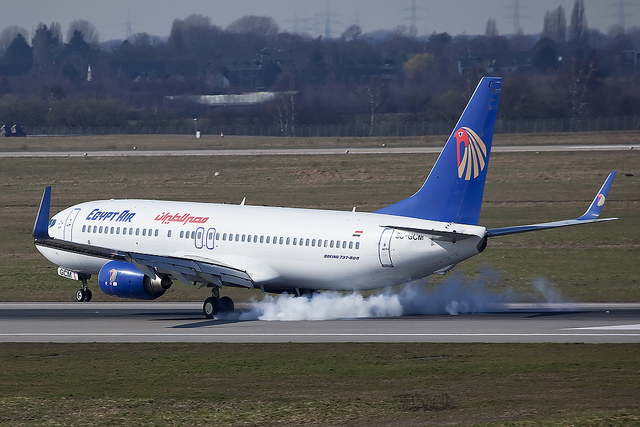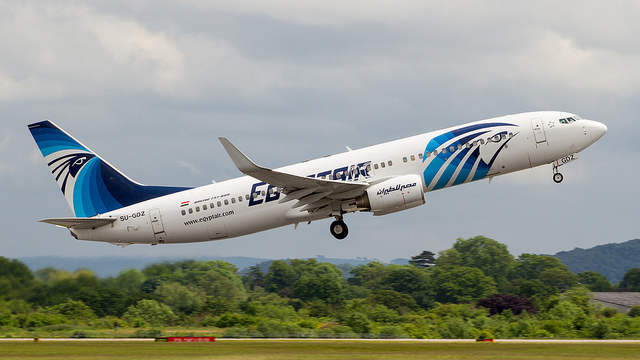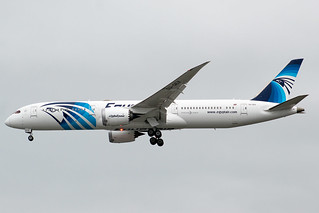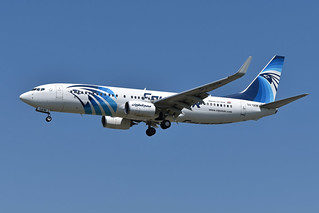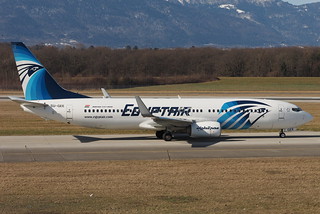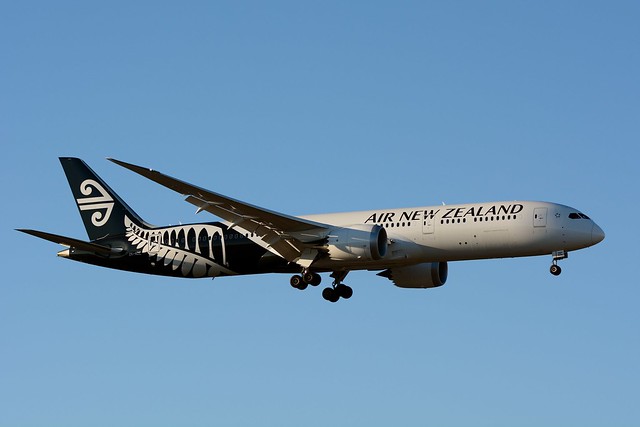Egypt A320 over Mediterranean on May 19th 2016, fire on board, traces of explosives found
Last Update: July 6, 2018 / 18:48:17 GMT/Zulu time
Incident Facts
Date of incident
May 19, 2016
Classification
Crash
Airline
Egypt Air
Aircraft Registration
SU-GCC
Aircraft Type
Airbus A320
ICAO Type Designator
A320
SAFETY INVESTIGATION INTO AIRBUS A320 ACCIDENT, REGISTERED SU-GCC AND OPERATED BY EGYPTAIR, ON 19/05/2016 OFF THE EGYPTIAN COAST
- REVIEW OF SITUATION ON 6 JULY 2018 -
Following the accident on 19 May 2016 over the Mediterranean Sea involving an Airbus A320 registered SU-GCC operated by EgyptAir, a safety investigation was immediately opened. In compliance with the international texts in force, as the accident occurred in international waters, Egypt, as the State of Registry and State of the Operator of the aeroplane, is in charge of carrying out this investigation. The BEA appointed an Accredited Representative to represent France as the State of Design of the aeroplane, assisted by technical advisers from the aircraft manufacturer, Airbus. The NTSB (1) also appointed an Accredited Representative to represent the United States as the State of Manufacture of the engine.
France contributed to the safety investigation from the very outset. Initially, the BEA’s work consisted in acting as advisor to its Egyptian counterpart and then in participating in sea search operations for the aircraft wreckage. At the same time, the three States collaborated in collecting and analysing the first elements available - in particular the ACARS (2) messages.
Once the wreckage had been found, the debris was inspected and the flight recorders were located, retrieved and immediately sent to Cairo in order to start the initial work to recover and read the data. These operations, collectively decided on and carried out by the Egyptian, American and French specialists, did not succeed in reading the recorded data due to the severe damage to the data media. Advanced repair work was then necessary and the BEA was asked to carry it out in its laboratory in France.
The work on the flight recorders was carried out under the authority of the Egyptian Investigator In Charge, on the BEA premises, and at the beginning of July 2016 the data from the two flight recorders was extracted, read and decoded.
During this work, the Egyptian authorities published the following elements about the accident:
- The flight recorders stopped operating while the aircraft was in cruise at an altitude of 37,000 feet;
- The aircraft systems sent ACARS messages indicating the presence of smoke in toilets and the avionics bay;
- The data from the data recorder confirms these messages;
- The playback of the cockpit voice recorder reveals, in particular, that the crew mentioned the existence of a fire on board;
- Several pieces of debris were retrieved from the accident site. Some of these had signs of having been subject to high temperatures, and traces of soot.
Once the data from the flight recorders had been retrieved, the Egyptian authorities continued their work in Egypt.
In addition, the BEA had collected the following elements:
- A signal from an emergency locator transmitter was sent at 00:37 (source CNES (3) ) i.e. around eight minutes after the transmission of the last ACARS message;
- Data from a Greek primary radar (sent by the Greek authorities to the BEA) shows that the aeroplane had descended in a turn until collision with the surface of the water.
Based on these elements, the BEA considers that the most likely hypothesis is that a fire broke out in the cockpit while the aeroplane was flying at its cruise altitude and that the fire spread rapidly resulting in the loss of control of the aeroplane.
For its part, the BEA’s Egyptian counterpart announced in December 2016, the discovery of traces of explosive on human remains. It stated that, in accordance with Egyptian legislation, this finding led it to transfer the file to the Egyptian Attorney General who would from now on be responsible for carrying out the investigation.
The BEA’s proposals concerning further work on the debris and recorded data were not, as far as the BEA knows, followed up. The technical elements of the investigation already collected by Egypt, including those provided by the BEA, are protected by the Egyptian judicial investigation.
In an effort to continue the safety investigation mission, the BEA asked to meet the Egyptian Attorney General. This took place at the end of May 2018. In this meeting, the Egyptian authorities explained that as it had been determined that there had been a malicious act, the investigation now fell within the sole jurisdiction of the judicial authorities.
The BEA’s Egyptian counterpart did not publish the final report which would have allowed the BEA to set out its differences of opinion as authorized by the international provisions.
The BEA considers that it is necessary to have this final report in order to have the possibility of understanding the cause of the accident and to provide the aviation community with the safety lessons which could prevent future accidents.
As mentioned above, the BEA considers that the most likely hypothesis is the rapid spread of a fire and would like investigations into this hypothesis to be continued in the interests of aviation safety.
The BEA is ready to continue its collaboration with its Egyptian counterpart should the latter restart the safety investigation into this accident.
Incident Facts
Date of incident
May 19, 2016
Classification
Crash
Airline
Egypt Air
Aircraft Registration
SU-GCC
Aircraft Type
Airbus A320
ICAO Type Designator
A320
This article is published under license from Avherald.com. © of text by Avherald.com.
Article source
You can read 2 more free articles without a subscription.
Subscribe now and continue reading without any limits!
Read unlimited articles and receive our daily update briefing. Gain better insights into what is happening in commercial aviation safety.
Send tip
Support AeroInside by sending a small tip amount.
Related articles
Egypt B738 at Alexandria on Apr 12th 2024, engine failure
An Egypt Air Boeing 737-800, registration SU-GCM performing positioning flight MS-4413 from Alexandria (Egypt) to Jeddah (Saudi Arabia), was climbing…
Egypt B738 at Entebbe on Mar 1st 2024, bird strike
An Egypt Air Boeing 737-800, registration SU-GDZ performing flight MS-835 from Entebbe (Uganda) to Cairo (Egypt) with 116 people on board, was…
Egypt B789 over Atlantic on Jan 20th 2024, cracked windshield
An Egypt Air Boeing 787-9, registration SU-GEV performing flight MS-987 from Cairo (Egypt) to Newark,NJ (USA), was enroute at FL360 over the Atlantic…
Egypt B738 at Jeddah on May 28th 2023, tyre damage on landing
An Egypt Air Boeing 737-800, registration SU-GEM performing flight MS-643 from Cairo (Egypt) to Jeddah (Saudi Arabia), landed on Jeddah's runway 16R…
Egypt B738 at Madinah on Oct 25th 2021, burst nose tyres on touch down
An Egypt Air Boeing 737-800, registration SU-GEE performing flight MS-2677 from Cairo (Egypt) to Madinah (Saudi Arabia) with 109 passengers and 7…
Newest articles
Engineering the future: The intersection of technology and aviation education
Can you imagine a world without technology? What would have started as something that made life easier has grown to become something we can't live…
ANZ B789 over Timor Sea on Apr 16th 2024, turbulence injures passenger
An ANZ Air New Zealand Boeing 787-9, registration ZK-NZC performing flight NZ-65 from Denpasar (Indonesia) to Auckland (New Zealand), had just…
Subscribe today
Are you researching aviation incidents? Get access to AeroInside Insights, unlimited read access and receive the daily newsletter.
Pick your plan and subscribePartner

A new way to document and demonstrate airworthiness compliance and aircraft value. Find out more.

ELITE Simulation Solutions is a leading global provider of Flight Simulation Training Devices, IFR training software as well as flight controls and related services. Find out more.

Your regulation partner, specialists in aviation safety and compliance; providing training, auditing, and consultancy services. Find out more.
AeroInside Blog
Popular aircraft
Airbus A320Boeing 737-800
Boeing 737-800 MAX
Popular airlines
American AirlinesUnited
Delta
Air Canada
Lufthansa
British Airways
